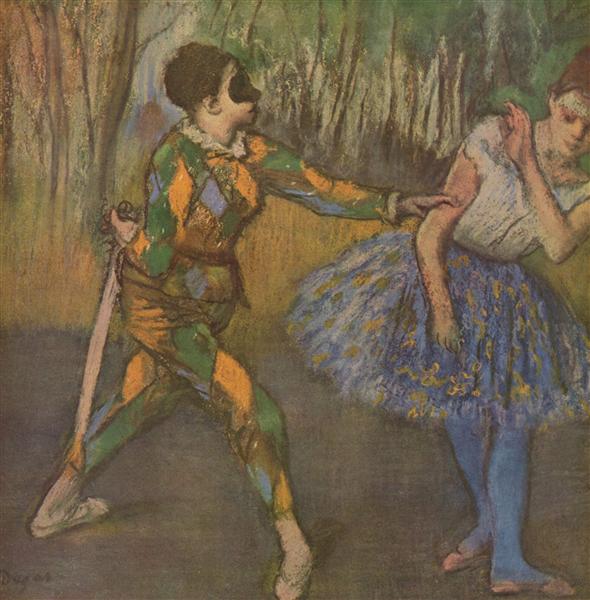Beskrivelse
Edgar Degas's Harlequin and Columbine (1886) is a fascinating example of the artist's ability to capture the essence of theatre and everyday life through painting. Known for his innovative use of composition and colour, Degas combines in this work the representation of love and the games of life, personified in the two commedia dell'arte characters depicted: Harlequin and Columbine. This work is not only a testament to his technical prowess, but also a visual proposition that invites reflection on human interactions and the nature of art as representation.
The musical composition of the work is remarkable. The characters, Harlequin and Columbine, are placed in an environment evoking a theatrical stage, where the male figure is in a slight turn to the right, while Columbine, with her dress that highlights a palette of whites and blues, faces him, creating an intimate and visual dialogue between the two. The arrangement of the figures adds to the dramatic narrative; the closeness of the characters suggests a deep connection, driven by the spatial proximity that Degas achieves with his masterful use of space.
Colour plays an essential role in this work. Harlequin’s vibrant costume, which features a mix of red, yellow and green hues, contrasts with the softness of Columbine’s dress, which is predominantly white with some more subtle details in her attire. This colour choice not only creates a powerful visual contrast, but also encapsulates the essence of playfulness and fun characteristic of commedia dell’arte, as well as an innocent sensuality that permeates the scene. The darker-toned backgrounds suggest that the viewer’s attention should be focused on the characters, highlighting their vitality and emotion.
In addition to the nod to commedia dell'arte archetypes, the work also features a number of nuances that reflect Degas's evolution as an artist. Unlike some of his better-known ballet works, there is a greater focus here on emotive narrative and the depiction of the human body in motion. Degas, though renowned for his exploration of the female figure in domestic and dance settings, shows his ability to invert this style by placing a male character in the foreground, who is not only visually appealing but also dynamic in his depiction.
Throughout his career, Degas experimented with different techniques and styles, and Harlequin and Columbine is no exception. The work is a testament to his ability to use pastel and blend techniques in a unique way. The soft texture and loose brushstrokes allow for a vibrant interplay of light and shadow, bringing a sense of movement and vitality to the characters, reflecting how art can go beyond the merely visual to capture the essence of the human experience.
In short, Edgar Degas's "Harlequin and Columbine" is a work that transcends its superficial representation. It is a dialogue between love, theater, and the liveliness of the characters, framed within the artist's technical mastery. The painting invites us to explore not only the very act of observing, but also to reflect on the complexity of human relationships, identities, and art as a whole. Through this work, Degas continues to challenge and captivate audiences, cementing his place in art history as one of the great innovators of his time.
KUADROS ©, a famous painting on your wall.
Hand-made oil painting reproductions, with the quality of professional artists and the distinctive seal of KUADROS ©.
Painting reproduction service with satisfaction guarantee. If you are not completely satisfied with the replica of your painting, we will refund 100% of your money.

